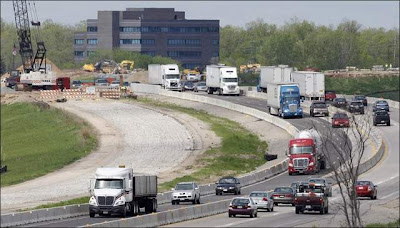Gov. Scott Walker, state transportation officials and local business leaders want to promote northeastern Wisconsin with an unmistakable U.S. brand that brings to mind speed, safety and reliability.
The brand — the Interstate Highway System — serves most major U.S. cities and facilitates the distribution of goods and services necessary for business to thrive.
Designating the 142-mile section of U.S. 41 between Green Bay and Milwaukee as an interstate highway would serve as a big boost to the Fox Valley, said Thom Ciske, vice president of governmental affairs for the Fox Cities Chamber of Commerce & Industry.
"To most big companies, major roadway means interstate," Ciske said. "Not that it's capable of handling interstate traffic, not that it works like an interstate, but the fact that it is an interstate. If you look at a map of our area and you see that interstate shield, you know it's a major highway."
The last interstate conversion in Wisconsin occurred in 1996, when U.S. 51 became I-39 between Portage and Wausau.
Dan Mahoney, village administrator for Plover, said the I-39 designation spurred economic development along the corridor, including a $75 million Crossroads Commons retail development and a $40 million Village Park at Plover retail development.
Mahoney said developers gravitate toward interstate highways.
"If you have interstate access, it puts you on the A list," he said. "If you don't have those connections, they may still look at you, but there's something about the interstate status that really elevates economic development in a region. It was very important for us."
The red, white and blue interstate shield also translated into economic development for communities along I-43 between Green Bay and Milwaukee after its conversion from U.S. 141 in the early 1980s.Fred Monique, interim president of the Green Bay Area Chamber of Commerce, said a 2008 study of the I-43 corridor showed the number of retail businesses along the route increased 19 percent in the first decade.
The brand — the Interstate Highway System — serves most major U.S. cities and facilitates the distribution of goods and services necessary for business to thrive.
Designating the 142-mile section of U.S. 41 between Green Bay and Milwaukee as an interstate highway would serve as a big boost to the Fox Valley, said Thom Ciske, vice president of governmental affairs for the Fox Cities Chamber of Commerce & Industry.
"To most big companies, major roadway means interstate," Ciske said. "Not that it's capable of handling interstate traffic, not that it works like an interstate, but the fact that it is an interstate. If you look at a map of our area and you see that interstate shield, you know it's a major highway."
The last interstate conversion in Wisconsin occurred in 1996, when U.S. 51 became I-39 between Portage and Wausau.
Dan Mahoney, village administrator for Plover, said the I-39 designation spurred economic development along the corridor, including a $75 million Crossroads Commons retail development and a $40 million Village Park at Plover retail development.
Mahoney said developers gravitate toward interstate highways.
"If you have interstate access, it puts you on the A list," he said. "If you don't have those connections, they may still look at you, but there's something about the interstate status that really elevates economic development in a region. It was very important for us."
The red, white and blue interstate shield also translated into economic development for communities along I-43 between Green Bay and Milwaukee after its conversion from U.S. 141 in the early 1980s.Fred Monique, interim president of the Green Bay Area Chamber of Commerce, said a 2008 study of the I-43 corridor showed the number of retail businesses along the route increased 19 percent in the first decade.




